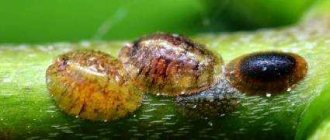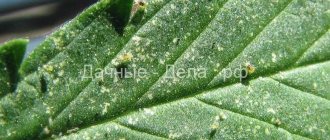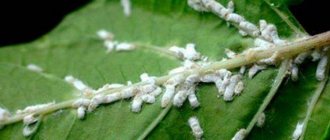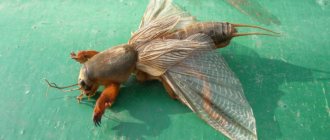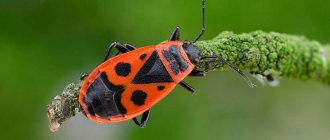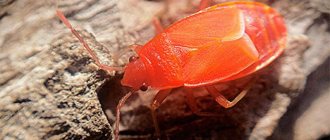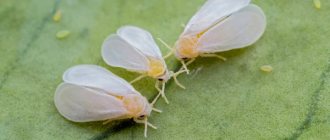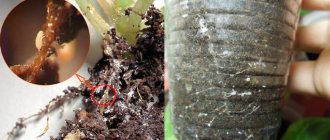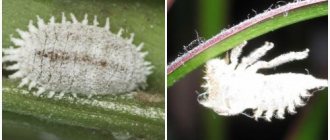- August 22, 2018
- Diseases and pests
- Legina Marina
If a sticky coating appears on your plants, then you need to immediately inspect the bottom of each leaf. The fact is that such symptoms very often indicate the presence of scale insects. Unlike most small pests, it is clearly visible on the surface of the leaf blade. It is the scale insect that is different in that it secretes a sticky liquid that seals the stomata and prevents the plant from breathing. At the same time, this film is an excellent breeding ground for fungi and bacteria. Today we’ll talk about what to do with scale insects on indoor plants and how to fight them. The photo will help you quickly identify this pest and select adequate control methods.
general description
What does this insect look like? This is a tiny creature that can destroy even a large tree. Its body is covered with a dense protective shell, so the scale insects can be mistaken for hard growths on the plant. It’s not for nothing that scale insects have a second name – garden turtle. But they are not at all as harmless as they might seem at first glance. In a couple of weeks, the voracious creatures will destroy any plant.
Every gardener should know well what scale insects look like on indoor plants and how to fight them. The photo shows us females up to 5 mm in length. They are the ones that are found motionless on plants and look like droplets of frozen resin. Males do not grow more than 3 mm and move freely around plants using legs or wings.
Types of scale insects that parasitize houseplants
The sizes and colors of scale insects of different species vary greatly.
The most common types:
- Californian - has a round shield. In the center, females have 2 rusty-brown skins with a white border. Males have a dark stripe across them.
- Cactus. Males are orange, females are pale yellow, with a round shield.
- Palm. The scutellum of females is translucent, flat, round in shape. The larvae are elongated, white and fluffy. Males are pale yellow.
There are thousands of species of scale insects, it is impossible to describe them all. Everyone has more in common than they have different things. They are distinguished by their gluttony and rapid reproduction. Larvae and females damage plants.
Reason for appearance
In the garden everything is clear: young females and males fly freely and cover considerable distances. How does scale insect appear on indoor plants? How to fight? We will look at photos of effective drugs below, but for now we will look at ways of penetration into your home. This is usually soil, plant debris and water. And most often, parasites come to your house with new plants.
They usually begin to fight them when they appear en masse, without previously noticing them. Therefore, a new generation of scale insects spreads into neighboring pots. And only sudden, massive shedding of leaves, inhibition of growth or death of plants can become a signal for the owner that it is time to show maximum care.
What is the danger
The insect spoils the green mass, trunks, and causes tissue pathologies. Females cling with a developed piercing proboscis and absorb plant sap. Adult females and larvae are harmful - they suck the root system, branches, leaves, leading the plant to death.
Typical damage:
• false scale insects suck out the juice and replace the voids with poison. Toxins impair photosynthesis, the plates become covered with spots of yellow, yellow-brown color. The defect spreads quickly, the leaves die;
• The scale insect does not produce poison, but honeydew. The sweet secretion accumulates dust, attracts ants, and becomes a source of fungal and viral infections. A dark, moldy coating appears on diseased leaves. It blocks photosynthesis, preventing sunlight from reaching the plates.
Growths develop intensively - stems and foliage are covered with rounded plaques of brown, yellow or green shades. There is curvature of healthy tissues caused by cell hypertrophy.
The plant weakens, the green mass withers, turns yellow, and falls off. Blooming specimens change shape and color of flowers. Gradually, necrosis of the trunk occurs. With severe infection, all parts die.
Peculiarity! Scale insects secrete a sugary secretion on which saprophytic fungi settle. Gradually, niello and honeydew form. The decorative appearance, development and growth processes are disrupted.
The insect migrates quickly. The larvae crawl to the sides, rarely remaining on the mother flower. They find areas convenient for sucking, fixate, feed, and grow.
Threatened
Scale insects can appear on indoor plants no matter how well you care for them. Moreover, it affects any plant, including succulents. But this pest also has its favorites, which are attacked first. We are talking about orchids and laurels. Palm trees and ivy do not avoid scale insects. With great pleasure, the scale insect feasts on Cyperus, Aucuba and other exotics. The usual household inhabitants are also under attack: chlorophytums, geraniums and hippeastrums.
What is noteworthy is that the pest most often appears in winter and early spring. This is evidenced by numerous amateur photos. How to deal with scale insects on indoor plants? It is necessary to improve the immunity of the plantings. After all, at this time the plants are most weakened, which becomes a decisive factor for the pest. It is much easier for them to harm flowers that are not able to resist. Therefore, follow the recommended conditions, and closer to spring add special immunostimulants to the soil. This could be inexpensive succinic acid.
Reproduction and life activity
Scale insects live in colonies, which is why they can cause significant damage to the plant. They “suck out” all the useful substances necessary for growth, development and photosynthesis. Scale insects reproduce by laying eggs, from which larvae subsequently emerge . They spread throughout the plant and are localized in small groups. This can be noticed by the appearance of unusual growths and curvatures on the trunk.
Significant damage is:
- drying of shoots;
- yellowing and falling of leaves.
Usually there are one or two generations (offspring) per year. But at one time the female lays about 3000 eggs. As for life expectancy, for males it is only from 1 to 3 days, and for females it is months. But the males have wings, they can fly to different parts of the plant, and even move independently over long distances.
The full development cycle of an insect is 45-65 days. Having destroyed 1 generation, you no longer have to worry about this pest.
Damage caused
The larvae wait in the wings, feeding on cell sap. With severe damage, plants become covered with a coating of pest bodies, and it is almost impossible not to notice this. Autumn is coming in your home garden, the leaves are flying away.
The scale insect and its larvae can live and feed on indoor plants all year round, and the insects reproduce very quickly. They reproduce by laying eggs, which contributes to rapid population growth. At the initial stage, the larvae are very mobile, especially the males. But they live only a few days, and the female will feed and breed for several months.
Where does the pest come from on house flowers?
They can be very different. The plant may have already been sold as infected. Then the methods of control depend only on how highly developed the pest is and how much damage it has already caused.
- Scale insect larvae can be carried by the wind, fly onto a balcony or through an open window. Or the infection could have occurred in a summer cottage.
- If a plant is grown in unsuitable conditions for it (too hot, humid, cold, insufficient nutrition, etc.), it also contributes to the appearance of parasites and diseases.
- If a flower is “overfed,” especially with nitrogen, this significantly weakens its immunity.
Do not confuse with false scale insects
This is another pest that appears very similar in appearance. These insects belong to the same order, but they are separated into a separate family. They differ from scale insects in that the latter do not have a waxy shell. Their eggs and larvae are protected by the dry skin of the dying female after laying. In the first stages, small insects move quickly, and this applies to both true and false scale insects. But if you see that a sticky patch begins to form on the leaves, there is no longer any doubt: this is what you are looking at.
What is post-acne
Acne can appear on the face and neck, in the interscapular area, on the back and in the upper chest. Acne or acne is the formation of inflammatory elements on the skin - compacted reddened tubercles (papules) and blackheads, purulent white heads with redness around them. If elements are injured, squeezed out or heal poorly, post-inflammatory, scarring, and pigmentary changes form on the skin - this is post-acne.
This is what post-acne looks like
Preventive actions
Below we will talk about how to deal with scale insects on indoor plants, but for now let’s look at what can be done to prevent damage. The following measures will help protect your flowers:
- Constant control of the soil in plant pots. It must be of high quality and clean.
- Dead and weak shoots must be cut off in a timely manner. This will preserve the strength of the plant and prevent rotting. Be sure to disinfect the sections.
- Ventilate the room frequently and maintain the required air humidity.
- Quarantine all new plants for a month. A similar technique should be used when returning your plants from their summer residence in the garden, in the fresh air. There are quite a lot of chances to become infected with scale insects in the garden.
Characteristic signs of scale insect damage
The appearance of the plant changes when sexually mature females are not yet visible. The foliage becomes dull despite abundant watering.
A sticky coating appears on some leaves. The female scale insect secretes a sweetish liquid - honeydew. This secretion becomes a favorable environment for another pest - sooty fungus (mob). Later, sticky marks appear around the pot on the windowsill and on the glass.
With the naked eye, you can see brown-gray plaques on the stem or leaves, around which yellowish spots grow.
The foliage becomes deformed and begins to fall. Young shoots dry out and become distorted. Cracks appear on the bark. The plant may drop buds. The growth and development of the flower slows down.
Fighting methods
The more pests manage to multiply, the more difficult it will be to get rid of them, and the more severe the damage caused. And the first remedy for scale insects on indoor plants is to pick them from the leaves by hand. It should be noted that the fight against these creatures is long and very difficult. A durable shell reliably protects pests from any damage. Therefore, first of all, we examine the axils and leaves on both sides. A small flat growth is a pest. It must be carefully torn from the plant and destroyed. To make this task easier, you can use a toothbrush. This is only the first, but a very important step. Because by leaving pests on the stems, you give them a chance to reproduce.
How to prevent acne and post-acne
To prevent acne and the development of post-acne, you must follow the rules of face and body care. It is important to use cleansing and skin care products selected for your age and skin type, and use them only for their intended purpose and according to the instructions.
Do not squeeze blackheads or white pimples.
To speed up their healing, you can use special creams, serums or other targeted products. If acne does not go away or its number increases, a visit to a dermatologist is necessary.
To protect your skin from inflammation, try not to touch your face or rub it with your hands during the day; if you talk on the phone a lot, treat your gadget, as there are always a lot of bacteria on it that get on the skin.
Change your towels more often or ditch them in favor of disposable paper towels. Be sure to wash your face twice a day and take a shower. For washing, you need to choose mild cleansers. If you are prone to acne, you need a soft, delicate and well-cleansing cosmetic product. Regular soap or shower gel may be too harsh.
Hygiene measures
The fight against scale insects on indoor plants begins with treatment with a soap solution. Most pests cannot tolerate this. Moreover, both the placement of the pots and the vessels themselves will need to be treated. It is best to replace the soil by first calcining the fresh soil mixture.
To prepare a concentrated soap solution you will need 100 g of grated laundry soap and a liter of water. After complete dissolution, add 200 ml of kerosene. All this must be thoroughly mixed until a white foam forms. Before use, the mixture must be diluted in 10 liters of water. After wiping with this solution, the plant is given a warm shower a few hours later, after which it is placed in a warm place to dry. This is one of the gentlest remedies, but it can be quite effective. True, there is a chance that the larvae will survive and give birth again. For complete victory, 2 to 3 treatments may be required at intervals of 7 days. The fight against scale insects on indoor plants can be long and difficult, so let's look at more reliable means.
How to cure lichen in a child
18.01.2022
Almost every second child at an early age manages to catch such a contagious disease as lichen . Before parents begin to solve the question: how to cure lichen , you need to understand what this disease looks like and what types of it exist.
How to cure lichen in a child?
Most often in children, pityriasis , one of the mildest forms of the disease. It makes itself felt by the appearance of pinkish spots on the body, flaking from the middle. Pink lichen often goes away without any intervention, but in order to clarify the diagnosis and not confuse it with red or multi-colored lichen , you need to take the child to the hospital .
Shingles cannot be confused with other types; it is very severe, has a viral nature, can recur again and again and cause complications . Skin rashes with this disease are similar to herpes, filled with fluid and very painful. The child has a fever and general weakness. Treatment is carried out with the help of antiviral drugs, immunomodulators and external ointments or creams, always under the supervision of a doctor .
The appearance of ringworm , which forms bald spots on a child’s hair, is associated with a fungal infection of the skin. to a doctor immediately . is treated with oral antibacterial drugs (Griseofulvin) and external antifungal agents (Clotrimazole, Lamisil).
How to avoid deprivation?
- Dress your baby in natural cotton clothes. Synthetic clothing does not allow the skin to breathe and promotes sweating .
- If it so happens that lichen occurs on warm summer days, then in order to get rid of it faster, you will have to postpone walks in sunny weather, or at least cover the affected areas of the skin with clothes.
- Water procedures should now also be limited; the lichen come into contact with water, otherwise it will spread more rapidly.
- Pay twice as much attention to your baby’s personal hygiene; all his things should be washed and boiled more often, separately from other things, and be sure to iron them.
- Disinfect the apartment, remove soft toys, carpets and other household items that may harbor pathogenic spores.
The signs of different types of lichen are sometimes very similar, and even an experienced specialist cannot always visually reliably determine what type of lichen the disease is and how to cure lichen in a child. Therefore, folk remedies are unlikely to help achieve the desired result, but by taking simple preventive measures, you can prevent the spread of the disease.
Published in Dermatology, Pediatrics Premium Clinic
Traditional methods
So, we cleaned the plant from pests with a toothbrush, washed it with soapy water and dried it well. Now we consider further how to deal with scale insects on indoor plants using available means:
- Garlic solution gives good results. To do this, add 5 crushed cloves to a glass of water and leave in a dark place. After this, strain through cheesecloth and spray the plant with the solution. You need to carry out a number of treatments to get a good result.
- Pepper infusion. Another advantage is that the solution can be prepared for future use. To do this, boil 50 g of pepper for 5 minutes in 500 g of water. Let it sit for 24 hours and the infusion is ready.
- Celandine. Almost all pests cannot tolerate it. You will need to pour 300 g of dry celandine herb with a liter of boiling water. Leave for 24 hours, then spray the diseased plant.
- Oil film. Insects are living creatures that require air. To block its access, you can lubricate the affected areas with sunflower oil using a brush. The procedure is repeated every day until the insects completely disappear.
The effectiveness of folk remedies is quite difficult to assess. They are safe for humans, which is a big plus. But often gardeners are faced with the fact that the result is temporary and comparable to manual collection of pests. Within a few days, the larva hatches, and the surviving individuals lay new eggs. And now a new generation of pests is destroying your flowers. Of course, on a garden scale it is more difficult to deal with them. But if you have 3 - 5 pots at home, then you can check every leaf every day and not give the pest a single chance.
Rules for processing plants
If even one scale insect is found on a plant, it is isolated. They check the rest, perhaps pests have also settled on them. The earlier parasites are identified, the easier it is to fight them. The larvae are destroyed by all available means, and adults, thanks to the shield, are insensitive to folk remedies; insecticides will be required.
It is easier to remove scale insects from plants with large flat leaves. They should be inspected regularly and adults and larvae removed manually. It is easy to wash such plants, but if the leaves are small, difficulties arise. One hand cleaning will help, but scale insects are completely removed with insecticides.
After removing the insects, the leaves are wiped on both sides with a solution: soap, kerosene, alcohol. Don't forget to wipe the trunk and branches. Then they are treated with insecticides. They wipe the place where the flower stood, the window glass. Pests are very small, so they are invisible on the surface.
Orchids
The first mandatory measure after detecting scale insects is to isolate the plant. If there are no chemicals, folk remedies are not prepared, simple emergency measures are taken. The orchid is placed under the tap, washed with a gentle stream of warm water, then treated with a soap solution. You can keep your plants moist by frequently spraying them with warm water from a spray bottle.
Another method is more effective. The orchid and the pot are covered with a plastic bag. Conditions with high humidity are formed, which the larvae cannot tolerate and die. To prevent the flower from disappearing, remove the bag every day for half an hour for ventilation. Measures to get rid of pests are complemented by the use of insecticides. Plants and soil are treated with solutions.
Velcro for flies and mosquitoes is installed next to the quarantined orchid. Scale insects can move to other plants by clinging to an insect.
lemon
It is better to refrain from using insecticides on lemon. Citrus growers consider the best solution to be a soap solution with 5 drops of kerosene per 1 liter of water. A film of soap blocks the access of air for scale insects; kerosene, when it gets on the body of pests, acts as a poison. The citrus is completely treated with the solution and washed off with water after 3 hours.
In order for the plant to recover faster from stress, it is fed with the biostimulant “Epin”. The treatment drug is applied by spraying.
Ficus
Scale insects are removed from plants manually. Use a sponge soaked in a soap-kerosene solution. Scrape off the branches with a knife. Shoots, leaves of ficus benjamina and other species affected by scale insects are removed. In parallel, chemicals are used 3–6 times with weekly breaks.
Other plants
Treatment of plants against scale insects gives results if comprehensive measures are used. Begin by washing with warm water and soap solutions. If the size of the plants allows, set up a mini-greenhouse by covering the plant with a plastic bag. Manual processing is carried out to remove scale insects.
Only chemical treatment will bring temporary results. The larvae die, but many adult scale insects, covered with a shell, survive. New larvae soon emerge from the eggs.
We use insecticides
A photo of a scale insect on indoor plants makes it clear that it can cause serious damage to any flower, even to the point of its complete death. Therefore, at the first sign of defeat, you need to get down to business. And the most effective way of control is the use of insecticides, that is, treatment with chemicals. But here, too, there is no guarantee that you will get by with just one treatment, because combating this pest requires a systematic approach. The choice of drugs today is quite large. But the most effective can be considered those that are designed to combat dipterous insects, including the Colorado potato beetle.
Habitat
The scale insect is distributed all over the world; many species came to us from other continents. Insects have many ways to expand their habitat. From remote regions and other countries, the pest comes along with plants brought by importers. It is not easy to detect it in small quantities, so when buying a flower in a store there is no guarantee that the pest will not enter the house.
One female is enough, which can produce offspring without an individual of the opposite sex.
Scale insects live on indoor flowers and in the garden. Plants wither and die due to pest invasion. You can bring insects home in the following ways:
- pick flowers from the field;
- buy an infected plant, from where scale insects will move to others;
- pests can migrate from neighbors through the balcony where flowers are displayed in the summer;
- rarely, but it happens that they are carried by the wind.
Interesting! Pests are able to move to new places along with other insects that can travel long distances.
"Aktara"
If you have tried traditional methods and are still looking for options on how to get rid of scale insects on indoor plants, then it’s time to move on to more radical measures. This drug affects the nervous system of insect pests, causing paralysis of the respiratory and nervous systems. The product is available in ampoules, which is very convenient.
This product destroys plant-feeding insects at all stages. The drug works equally well when applied to the leaves and watered at the root. That is, it accumulates in the vegetative parts of the plant, which makes it resistant to precipitation.
How to detect scale insects
Not many gardeners, especially beginners, manage to immediately detect the pest, and this is precisely the main reason for its spread. Usually people panic only when they begin to observe massive falling of leaves and wilting of plants.
However, there are several ways in which you can identify a pest and below you can familiarize yourself with them:
- Pay attention to the veins along the leaves. If you find strange convex round bumps or plaques on them, then know that this is a scale insect that needs to be dealt with urgently. Do not pay attention to the color of such tubercles, because in scale insects their shells can take on different shades.
- In the initial stages of appearance, the scale insect is almost impossible to identify due to its small size and camouflage methods. But due to their vital activity, they secrete sticky mucus that covers the leaves. Please note that if the leaves of your plant are sticky, then it is likely that you need to sound the alarm.
- Over time, red spots may appear on the leaves and stems and increase in size. If you also notice tubercles, then most likely your plant has been attacked by a scale insect.
- In later stages, pay attention to the early wilting of the leaves, deformation of the stem and their gradual drying. Inspect the plant, and if you find other signs of a pest attack, you will need to take immediate action.
- Falling of flowers and fruits and growth cessation is the extreme degree of pest damage to a plant. If you observe something like this, then know that by this moment the chance of saving the plant will be 50/50, but it’s worth a try in any case.
It is noteworthy that the scale insect can return to the plant it loves, so treatment must be carried out over a long period of time, preventative work must be constantly carried out, and the plant must also be constantly inspected. Because the reappearance of scale insects will also threaten you with sooty fungus, which will have to be treated separately.
"Aktellik"
And we continue to talk about how to fight scale insects on plants. "Actellik" is a popular insecticide that allows you to quickly deal with garden parasites. The drug "Actellik" CE, that is, a concentrated emulsion packaged in ampoules of 2 ml, contains the active ingredient pirimiphos-methyl. It can affect the pest in the following ways:
- Through outer shells.
- Through the digestive organs.
- through the respiratory tract.
The emulsion is widely used for indoor plants. It is non-toxic to people and pets when used correctly. Today this is one of the best means to combat scale insects.
What indoor plants are at risk?
Most often, insects settle on the following plants:
- ficus trees of all types;
- palms, especially fan palms;
- citrus fruits;
- orchids;
- sheflerakh.
Insects do not leave hibiscus, dracaenas, oleander, yucca, and anthurium with their attention. By damaging the protective shell, pests allow fungi to easily penetrate plant tissue through wounds.
To defeat the infection, indoor flowers are treated with the biological product “Fitoflavin”, which destroys almost all fungal diseases. Dosage – 2 ml per 1 liter of water.
"Fitoverm"
Experienced gardeners are well acquainted with this drug. It perfectly helps to cope with a wide variety of pests of both garden and potted plants. The drug must be diluted in a proportion of 1 ml per 200 ml of water. Fitoverm is not a highly toxic drug for humans and does not carry the risk of serious poisoning. This is one of its important advantages, along with its high efficiency in the fight against parasites. This is especially important since the drug is used in a residential area where other family members are located.
Why doesn't the Decembrist grow?
Schlumbergera may not grow due to several factors: insufficient feeding with mineral complexes or drying out of the substrate. During the growth period - from late March to August - it is necessary to fertilize with nitrogen and phosphorus, provide access to fresh air, cover from direct sunlight and do not forget about constant watering, spraying and washing with soft warm water. If the Decembrist dries out, the first thing to do is take cuttings and root again. Did you know? The life expectancy of zygocactus with proper care is very high - from 20 to 30 years.
"Fufanon"
This is the most popular drug used to treat cultivated and ornamental plants. Even in the garden he is able to remain active for two weeks. And if we talk about greenhouses and house plants, then the drug will retain its original concentration for up to a month. This is a huge plus, since you will not have to repeat the treatment after the larvae hatch. There is enough time to destroy all generations. With the help of this drug, the fight against scale insects on indoor plants becomes quite simple.
Its active substance malathion is highly toxic. This is a contact drug that has an effect on parasites upon direct contact with their bodies, respiratory and digestive organs. Of course, extreme care must be taken to ensure that pets and fish, as well as family members, are not harmed during processing.
All about the Decembrist flower
The flowering of the Decembrist is remembered for a long time, because its flowers have an unforgettable long-tubular multi-tiered shape. A bunch of rather long stamens hanging from the middle of a symmetrical flower gives it a spectacular and original look. In its natural environment, pollination of the plant occurs with the help of hummingbirds. Schlumbergera blooms in mid-summer, which in South America begins at the same time as winter begins in the Northern Hemisphere. This is precisely the reason why the plant is called Decembrist. Red and white flowers appear at the very tips of the stems. Over time, various varieties of plants have been developed, which can be either pink, yellow and white, or purple or crimson.
We recommend reading these articles:
Treatment of trees in the spring during bud break
Treatment of shrubs in the spring during bud break
Treating shrubs in the spring against pests and diseases with Bordeaux mixture
A rather unusual root system in natural conditions is accustomed to adapt to the difficult Brazilian forests. The fact is that in the tropics the necessary layer of soil is practically absent, so the roots of the Decembrist are weak, which can die very quickly. But at this moment, the so-called search roots come to the aid of the plant, which are capable of developing into full-fledged roots in the shortest possible time. In addition, they can transform into aerial roots (as in some varieties of Ficus Benjamin), which the bush needs to be saturated with oxygen and sufficient moisture.
Varvarin color differs from other cacti in that it grows very quickly. This is due to the fact that in the natural environment, having found itself in an environment that is most suitable for it, the plant wants to occupy as much space as possible, which will allow it to avoid meeting any competitors. This flower also produces abundant, unforgettable blooms, reproduces without much difficulty and can take root as quickly as possible, which allows it to keep other plants away from it.
Prevention
You can protect plants from pest attack by regularly ventilating the premises and maintaining a balance of light and water. When purchasing new plants, it is important to adhere to quarantine: keep them separately for 2-4 days.
Important rules for florists and gardeners:
- Carefully check the leaves regularly for signs of parasites or traces of their presence.
- Before contacting plants, be sure to wash your hands, as scale insects can be transferred to them.
- Wash the leaves under running water more often (the scale insect does not like moisture), the soil must be covered while doing this.
- Do not place the flower in the open sun, this can only harm it. It is enough to just choose a warm place.
Scale insects are a dangerous pest for garden and indoor plants , but with timely detection, you can avoid losses. Carry out preventive measures regularly, do not forget about the general rules of care: watering, fertilizing, strengthening the root system.
If you find an error, please select a piece of text and press Ctrl+Enter.
Why does the Decembrist shed its buds?
The flower drops its buds - as a rule, mites are to blame for this. If a spider mite caused damage, then the fallen leaves should have a yellow base with rusty-brown spots. Look carefully. If there are no mites or signs of them, slightly shake the Decembrist from side to side, it may have problems with the roots.
The root system is the weakest part of the Decembrist, it easily rots and dies off at the slightest mistake during care. If the plant wobbles, then it must be urgently transplanted into new soil and into a clean, disinfected old pot or into a new one.
All bad, acidic soil and affected roots are removed. Rinse the roots well under running warm water (40 - 50 degrees) to make sure they are in order.
It is a misconception that Decembrist loses leaves and flowers from lack of moisture. Therefore, they mistakenly begin to increase watering. The flower will begin to wither rather than shed its segments.
General information
The scale insect is a representative of the Hemiptera family, part of the order Pseudococcida. The pest got its name because of the waxy shell that covers its body . This shell can be easily separated: only the unprotected body of the parasite will remain. There are several varieties of scale insects.
REFERENCE! The average length of individuals is 5 mm; larger ones are also found (usually females). Males are active, they can fly, but live no more than 3 days. Females lay eggs, protect the larvae and live up to 4 months.
After hatching, the larvae are mobile, they are in search of food . Later, the individuals attach themselves to one place and begin to drink plant juice. A protective wax shell also appears over time. Scale insects prefer garden plants; indoor plants are less likely to be affected. Most often, the parasite attacks citrus fruits, bromeliads, and palm crops. The pest also feeds on the juices of poisonous plants.
